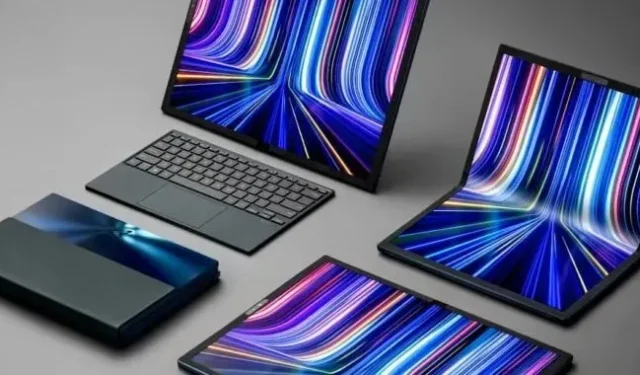When Intel unveiled its 12th generation mobile processors on Tuesday, the company indicated the suitability of the chips for use in foldable PC construction by showing unidentified concept images. It didn’t take long to understand what Intel was talking about. On Wednesday, Asus announced a foldable PC – think of it as a 17.3-inch OLED tablet that can be folded in half.
In addition to the 12th generation i7 processor, the Asus Zenbook 17 Fold OLED comes with 16GB of RAM and a 1TB PCIe 4.0 SSD. The components are housed in a device that measures 14.9 x 11.32 x 0.34-0.46 inches when open and contains an OLED touchscreen with a resolution of 2560 x 1920 and a 0.2ms GTG response time.
The display has a 4:3 aspect ratio, which makes it tall when fully open. If you fold it in the middle, the screen will work as two 12.5″displays with 1920 x 1290 resolution and a 3:2 aspect ratio. When you’re done, you can fold the device so it’s “smaller than a piece of copier paper”, measuring 11.69 x 8.27 inches, according to Asus. And if you’re worried about how many times you can fold the device, Asus claims the hinge will last at least 30,000 cycles.
Asus’ foldable OLED screen can reach 350 nits of brightness with SDR or 500 nits with HDR, covering an impressive 100 percent of DCI-P3. OLED is known to deliver vibrant colors, and Asus is touting a particularly wide range with the Zenbook 17 Fold OLED. The screen supports HDR with VESA DisplayHDR 500 certification. The display can also use the built-in color sensor to adjust brightness and color based on the environment.
The Zenbook 17 Fold OLED joins an entirely new category of foldable PCs that first took shape when Lenovo launched the ThinkPad X1 Fold in 2020.
Lenovo’s foldable PC is stuck with limited processor power, poor battery life and, as is always the case with foldable devices and new tech, a high price tag. Also, Windows 10 didn’t fit perfectly with the foldable design, especially since Microsoft abandoned plans to build an operating system designed for foldable devices.
More than a year later, Asus is producing a foldable PC with a larger screen, a new generation processor and a bigger battery. However, Asus has yet to name a price, and that will be an important part of the story.
The Zenbook 17 Fold OLED differs from the ThinkPad X1 Fold in its larger size. The Lenovo foldable screen has a 13.3-inch screen with a lower resolution of 2048 x 1536. The Lenovo size (11.8 x 9.3 x 0.5 inches unfolded, 2.2 pounds) makes it more portable. At 3.64 pounds, the Asus foldable model is heavier.
The Asus machine will use an Intel Core i7-1250U. Since Intel’s 12th generation mobile chips have just been announced, we haven’t seen them in action, but in terms of specs, the processor overall looks to be more powerful than in the X1 Fold.
The i7-1250U is rated at a clock speed of 1.1GHz, which can go up to 4.7GHz with two performance cores, eight efficient cores, and 12MB of cache. Lenovo’s foldable chassis uses the i5-L16G7, which has one performance core, four efficient cores, clocked at up to 3GHz, and 4MB of cache. You can still buy one today, but with half the RAM and storage of the upcoming Zenbook.


